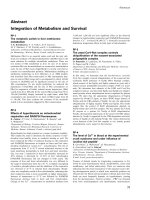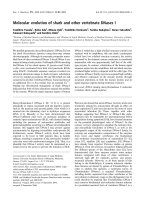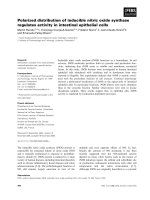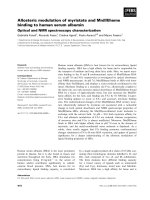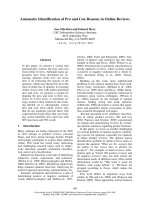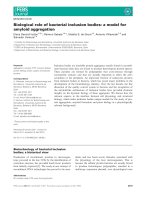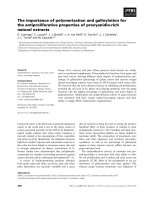Báo cáo khoa học: "Serial Combination of Rules and Statistics: A Case Study in Czech Tagging" potx
Bạn đang xem bản rút gọn của tài liệu. Xem và tải ngay bản đầy đủ của tài liệu tại đây (85.08 KB, 8 trang )
Serial Combination of Rules and Statistics: A Case Study in Czech
Tagging
Jan Haji
ˇ
c Pavel Krbec
IFAL
MFF UK
Prague
Czechia
hajic,krbec @
ufal.mff.cuni.cz
Pavel Kv
ˇ
eto
ˇ
n
ICNC
FF UK
Prague
Czechia
Pavel.Kveton@
ff.cuni.cz
Karel Oliva
Computational
Linguistics
Univ. of Saarland
Germany
oliva@
coli.uni-sb.de
Vladim
´
ır Petkevi
ˇ
c
ITCL
FF UK
Prague
Czechia
Vladimir.Petkevic@
ff.cuni.cz
Abstract
A hybrid system is described which
combines the strength of manual rule-
writing and statistical learning, obtain-
ing results superior to both methods if
applied separately. The combination of
a rule-based system and a statistical one
is not parallel but serial: the rule-based
system performing partial disambigua-
tion with recall close to 100% is applied
first, and a trigram HMM tagger runs on
its results. An experiment in Czech tag-
ging has been performed with encour-
aging results.
1 Tagging of Inflective Languages
Inflective languages pose a specific problem in
tagging due to two phenomena: highly inflec-
tive nature (causing sparse data problem in any
statistically-based system), and free word order
(causing fixed-context systems, such as n-gram
Hidden Markov Models (HMMs), to be even less
adequate than for English). The average tagset
contains about 1,000 - 2,000 distinct tags; the size
of the set of possible and plausible tags can reach
several thousands.
Apart from agglutinative languages such
as Turkish, Finnish and Hungarian (see e.g.
(Hakkani-Tur et al., 2000)), and Basque (Ezeiza
et al., 1998), which pose quite different and in
the end less severe problems, there have been at-
tempts at solving this problem for some of the
highly inflectional European languages, such as
(Daelemans et al., 1996), (Erjavec et al., 1999)
(Slovenian), (Hajiˇc and Hladk´a, 1997), (Hajiˇc and
Hladk´a, 1998) (Czech) and (Hajiˇc, 2000) (five
Central and Eastern European languages), but
so far no system has reached - in the absolute
terms - a performance comparable to English tag-
ging (such as (Ratnaparkhi, 1996)), which stands
around or above 97%. For example, (Hajiˇc and
Hladk´a, 1998) report results on Czech slightly
above 93% only. One has to realize that even
though such a performance might be adequate for
some tasks (such as word sense disambiguation),
for many other (such as parsing or translation) the
implied sentence error rate at 50% or more is sim-
ply too much to deal with.
1.1 Statistical Tagging
Statistical tagging of inflective languages
has been based on many techniques, rang-
ing from plain-old HMM taggers (M´ırovsk´y,
1998), memory-based (Erjavec et al., 1999) to
maximum-entropy and feature-based (Hajiˇc and
Hladk´a, 1998), (Hajiˇc, 2000). For Czech, the
best result achieved so far on approximately
300 thousand word training data set has been
described in (Hajiˇc and Hladk´a, 1998).
We are using 1.8M manually annotated tokens
from the Prague Dependency Treebank (PDT)
project (Hajiˇc, 1998). We have decided to work
with an HMM tagger
1
in the usual source-channel
setting, with proper smoothing. The HMM tag-
ger uses the Czech morphological processor from
PDT to disambiguate only among those tags
1
Mainly because of the ease with which it is trained even
on large data, and also because no other publicly available
tagger was able to cope with the amount and ambiguity of
the data in reasonable time.
which are morphologically plausible for a given
input word form.
1.2 Manual Rule-based Systems
The idea of tagging by means of hand-written
disambiguation rules has been put forward and
implemented for the first time in the form of
Constraint-Based Grammars (Karlsson et al.,
1995). From languages we are acquainted with,
the method has been applied on a larger scale only
to English (Karlsson et al., 1995), (Samuelsson
and Voutilainen, 1997), and French (Chanod and
Tapanainen, 1995). Also (Bick, 1996) and (Bick,
2000) use manually written rules for Brazilian
Portuguese, and there are several publications by
Oflazer for Turkish.
Authors of such systems claim that hand-
written systems can perform better than sys-
tems based on machine learning (Samuelsson and
Voutilainen, 1997); however, except for the work
cited, comparison is difficult to impossible due to
the fact that they do not use the standard evalua-
tion techniques (and not even the same data). But
the substantial disadvantage is that the develop-
ment of manual rule-based systems is demanding
and requires a good deal of very subtle linguistic
expertise and skills if full disambiguation also of
“difficult” texts is to be performed.
1.3 System Combination
Combination of (manual) rule-writing and statis-
tical learning has been studied before. E.g., (Ngai
and Yarowsky, 2000) and (Ngai, 2001) provide
a thorough description of many experiments in-
volving rule-based systems and statistical learn-
ers for NP bracketing. For tagging, combination
of purely statistical classifiers has been described
(Hladk´a, 2000), with about 3% relative improve-
ment (error reduction from 18.6% to 18%, trained
on small data) over the best original system. We
regard such systems as working in parallel, since
all the original classifiers run independently of
each other.
In the present study, we have chosen a differ-
ent strategy (similar to the one described for other
types of languages in (Tapanainen and Vouti-
lainen, 1994), (Ezeiza et al., 1998) and (Hakkani-
Tur et al., 2000)). At the same time, the rule-
based component is known to perform well in
eliminating the incorrect alternatives
2
, rather than
picking the correct one under all circumstances.
Moreover, the rule-based system used can exam-
ine the whole sentential context, again a difficult
thing for a statistical system
3
. That way, the ambi-
guity of the input text
4
decreases. This is exactly
what our statistical HMM tagger needs as its in-
put, since it is already capable of using the lexical
information from a dictionary.
However, also in the rule-based approach, there
is the usual tradeoff between precision and recall.
We have decided to go for the “perfect” solution:
to keep 100% recall, or very close to it, and grad-
ually improve precision by writing rules which
eliminate more and more incorrect tags. This way,
we can be sure (or almost sure) that the perfor-
mance of the HMM tagger performance will not
be hurt by (recall) errors made by the rule compo-
nent.
2 The Rule-based Component
2.1 Formal Means
Taken strictly formally, the rule-based component
has the form of a restarting automaton with dele-
tion (Pl´atek et al., 1995), that is, each rule can
be thought of as a finite-state automaton starting
from the beginning of the sentence and passing to
the right until it finds an input configuration on
which it can operate by deletion of some parts of
the input. Having performed this, the whole sys-
tem is restarted, which means that the next rule
is applied on the changed input (and this input is
again read from the left end). This means that a
single rule has the power of a finite state automa-
ton, but the system as a whole has (even more
than) a context-free power.
2.2 The Rules and Their Implementation
The system of hand-written rules for Czech has a
twofold objective:
practical: an error-free and at the same time
the most accurate tagging of Czech texts
theoretical: the description of the syntactic
2
Such a “negative” learning is thought to be difficult for
any statistical system.
3
Causing an immediate data sparseness problem.
4
As prepared by the morphological analyzer.
system of Czech, its langue, rather than pa-
role.
The rules are to reduce the input ambiguity of
the input text. During disambiguation the whole
rule system combines two methods:
the oblique one consisting in the elimination
of syntactically wrong tag(s), i.e. in the re-
duction of the input ambiguity by deleting
those tags which are excluded by the context
the direct choice of the correct tag(s).
The overall strategy of the rule system is to
keep the highest recall possible (i.e. 100%) and
gradually improve precision. Thus, the rules are
(manually) assigned reliabilities which divide the
rules into reliability classes, with the most reli-
able (“bullet-proof”) group of rules applied first
and less reliable groups of rules (threatening to
decrease the 100% recall) being applied in subse-
quent steps. The bullet-proof rules reflect general
syntactic regularities of Czech; for instance, no
word form in the nominative case can follow an
unambiguous preposition. The less reliable rules
can be exemplified by those accounting for some
special intricate relations of grammatical agree-
ment in Czech. Within each reliability group the
rules are applied independently, i.e. in any or-
der in a cyclic way until no ambiguity can be re-
solved.
Besides reliability, the rules can be generally
divided according to the locality/nonlocality of
their scope. Some phenomena (not many) in the
structure of Czech sentence are local in nature:
for instance, for the word “se” which is two-way
ambiguous between a preposition (with) and a re-
flexive particle/pronoun (himself, as a particle) a
prepositional reading can be available only in lo-
cal contexts requiring the vocalisation of the basic
form of the preposition “s” (with) resulting in the
form “se”. However, in the majority of phenom-
ena the correct disambiguation requires a much
wider context. Thus, the rules use as wide con-
text as possible with no context limitations be-
ing imposed in advance. During rules develop-
ment performed so far, sentential context has been
used, but nothing in principle limits the context
to a single sentence. If it is generally appropri-
ate for the disambiguation of the languages of the
world to use unlimited context, it is especially fit
for languages with free word order combined with
rich inflection. There are many syntactic phenom-
ena in Czech displaying the following property: a
word form wf1 can be part-of-speech determined
by means of another word form wf2 whose word-
order distance cannot be determined by a fixed
number of positions between the two word forms.
This is exactly a general phenomenon which is
grasped by the hand-written rules.
Formally, each rule consists of
the description of the context (descriptive
component), and
the action to be performed given the context
(executive component): i.e. which tags are
to be discarded or which tag(s) are to be pro-
claimed correct (the rest being discarded as
wrong).
For example,
Context: unambiguous finite verb, fol-
lowed/preceded by a sequence of tokens
containing neither comma nor coordinating
conjunction, at either side of a word x am-
biguous between a finite verb and another
reading
Action: delete the finite verb reading(s) at
the word x.
There are two ways of rule development:
the rules developed by syntactic introspec-
tion: such rules are subsequently verified on
the corpus material, then implemented and
the implemented rules are tested on a testing
corpus
the rules are derived from the corpus by in-
trospection and subsequently implemented
The rules are formulated as generally as pos-
sible and at the same time as error-free (recall-
wise) as possible. This approach of combining the
requirements of maximum recall and maximum
precision demands sophisticated syntactic knowl-
edge of Czech. This knowledge is primarily based
on the study of types of morphological ambiguity
occurring in Czech. There are two main types of
such ambiguity:
regular (paradigm-internal)
casual (lexical)
The regular (paradigm-internal) ambiguities
occur within a paradigm, i.e. they are common
to all lexemes belonging to a particular inflection
class. For example, in Czech (as in many other in-
flective languages), the nominative, the accusative
and the vocative case have the same form (in sin-
gular on the one hand, and in plural on the other).
The casual (lexical, paradigm-external) morpho-
logical ambiguity is lexically specific and hence
cannot be investigated via paradigmatics.
In addition to the general rules, the rule ap-
proach includes a module which accounts for col-
locations and idioms. The problem is that the
majority of collocations can – besides their most
probable interpretation just as collocations – have
also their literal meaning.
Currently, the system (as evaluated in Sect. 2.3)
consists of 80 rules.
The rules had been implemented procedurally
in the initial phase; a special feature-oriented, in-
terpreted “programming language” is now under
development.
2.3 Evaluation of the Rule System Alone
The results are presented in Table 1. We use the
usual equal-weight formula for F-measure:
where
and
3 The Statistical Component
3.1 The HMM Tagger
We have used an HMM tagger in the usual source-
channel setting, fine-tuned to perfection using
a 3-gram tag language model
,
a tag-to-word lexical (translation) model us-
ing bigram histories instead of just same-
word conditioning
5
,
5
First used in (Thede and Harper, 1999), as far as we
know.
a bucketed linear interpolation smoothing
for both models.
Thus the HMM tagger outputs a sequence of
tags according to the usual equation
where
and
The tagger has been trained in the usual way,
using part of the training data as heldout data for
smoothing of the two models employed. There
is no threshold being applied for low counts.
Smoothing has been done first without using
buckets, and then with them to show the differ-
ence. Table 2 shows the resulting interpolation
coefficients for the tag language model using the
usual linear interpolation smoothing formula
where p( ) is the “raw” Maximum Likelihood
estimate of the probability distributions, i.e. the
relative frequency in the training data.
The bucketing scheme for smoothing (a neces-
sity when keeping all tag trigrams and tag-to-
word bigrams) uses “buckets bounds” computed
according to the following formula (for more on
bucketing, see (Jelinek, 1997)):
It should be noted that when using this bucket-
ing scheme, the weights of the detailed distribu-
tions (with longest history) grow quickly as the
history reliability increases. However, it is not
monotonic; at several of the most reliable histo-
ries, the weight coefficients “jump” up and down.
We have found that a sudden drop in happens,
e.g., for the bucket containing a history consisting
of two consecutive punctuation symbols, which is
not so much surprising after all.
A similar formula has been used for the lex-
ical model (Table 3), and the strenghtening of
the weights of the most detailed distributions has
been observed, too.
Precision Recall F-measure ( )
Morphology output only (baseline; no rules applied) 28.97% 100.00% 44.92%
After application of the manually written rules 36.43% 99.66% 53.36%
Table 1: Evaluation of rules alone, average on all 5 test sets
no buckets 0.4371 0.5009 0.0600 0.0020
bucket 0 (least reliable histories) 0.0296 0.7894 0.1791 0.0019
bucket 1 0.1351 0.7120 0.1498 0.0031
bucket 2 0.2099 0.6474 0.1407 0.0019
bucket 32 (most reliable histories) 0.7538 0.2232 0.0224 0.0006
Table 2: Example smoothing coefficients for the tag language model (Exp 1 only)
3.2 Evaluation of the HMM Tagger alone
The HMM tagger described in the previous para-
graph has achieved results shown in Table 4. It
produces only the best tag sequence for every sen-
tence, therefore only accuracy is reported. Five-
fold cross-validation has been performed (Exp 1-
5) on a total data size of 1489983 tokens (exclud-
ing heldout data), divided up to five datasets of
roughly the same size.
4 The Serial Combination
When the two systems are coupled together, the
manual rules are run first, and then the HMM tag-
ger runs as usual, except it selects from only those
tags retained at individual tokens by the manual
rule component, instead of from all tags as pro-
duced by the morphological analyzer:
The morphological analyzer is run on the test
data set. Every input token receives a list
of possible tags based on an extensive Czech
morphological dictionary.
The manual rule component is run on the
output of the morphology. The rules elimi-
nate some tags which cannot form grammat-
ical sentences in Czech.
The HMM tagger is run on the output of
the rule component, using only the remain-
ing tags at every input token. The output is
best-only; i.e., the tagger outputs exactly one
tag per input token.
If there is no tag left at a given input token after
the manual rules run, we reinsert all the tags from
morphology and let the statistical tagger decide as
if no rules had been used.
4.1 Evaluation of the Combined Tagger
Table 5 contains the final evaluation of the main
contribution of this paper. Since the rule-based
component does not attempt at full disambigua-
tion, we can only use the F-measure for compari-
son and improvement evaluation
6
.
4.2 Error Analysis
The not-so-perfect recall of the rule component
has been caused either by some deficiency in the
rules, or by an error in the input morphology (due
to a deficiency in the morphological dictionary),
or by an error in the ’truth’ (caused by an imper-
fect manual annotation).
As Czech syntax is extremely complex, some
of the rules are either not yet absolutely perfect,
or they are too strict
7
. An example of the rule
which decreases 100% recall for the test data is
the following one:
In Czech, if an unambiguous preposition is de-
tected in a clause, it “must” be followed - not
necessarily immediately - by a nominal element
(noun, adjective, pronoun or numeral) or, in very
6
For the HMM tagger, which works in best-only mode,
accuracy = precision = recall = F-measure, of course.
7
“Too strict” is in fact good, given the overall scheme
with the statistical tagger coming next, except in cases when
it severely limits the possibility of increasing the precision.
Nothing unexpected is happening here.
no buckets 0.3873 0.4461 0.0000 0.1666
Table 3: Example smoothing coefficients for the lexical model, no buckets (Exp 1 only)
Accuracy (smoothing w/o bucketing) Accuracy (bucketing)
Exp 1 95.23% 95.34%
Exp 2 94.95% 95.13%
Exp 3 95.04% 95.19%
Exp 4 94.77% 95.04%
Exp 5 94.86% 95.11%
Average 94.97% 95.16%
Table 4: Evaluation of the HMM tagger, 5-fold cross-validation
special cases, such a nominal element may be
missing as it is elided. This fact about the syn-
tax of prepositions in Czech is accounted for by
a rule associating an unambiguous preposition
with such a nominal element which is headed by
the preposition. The rule, however, erroneously
ignores the fact that some prepositions function
as heads of plain adverbs only (e.g., adverbs of
time). As an example occurring in the test data
we can take a simple structure “do kdy” (lit. till
when), where “do” is a preposition (lit. till), when
is an adverb of time and no nominal element fol-
lows. This results in the deletion of the preposi-
tional interpretation of the preposition “do” thus
causing an error. However, in cases like this, it
is more appropriate to add another condition to
the context (gaining back the lost recall) of such a
rule rather than discard the rule as a whole (which
would harm the precision too much).
As examples of erroneous tagging results
which have been eliminated for good due to the
architecture described we might put forward:
preposition requiring case not followed by
any form in case : any preposition has to be
followed by at least one form (of noun, ad-
jective, pronoun or numeral) in the case re-
quired. Turning this around, if a word which
is ambiguous between a preposition and an-
other part of speech is not followed by the
respective form till the end of the sentence,
it is safe to discard the prepositional reading
in almost all non-idiomatic, non-coordinated
cases.
two finite verbs within a clause: Similarly
to most languages, a Czech clause must not
contain more than one finite verb. This
means that if two words, one genuine finite
verb and the other one ambiguous between a
finite verb and another reading, stand in such
a configuration that the material between
them contains no clause separator (comma,
conjunction), it is safe to discard the finite
verb reading with the ambiguous word.
two nominative cases within a clause: The
subject in Czech is usually case-marked by
nominative, and simultaneously, even when
the position of subject is free (it can stand
both to the left or to the right of the main
verb) in Czech, no clause can have two non-
coordinated subjects.
5 Conclusions
The improvements obtained (4.58% relative er-
ror reduction) beat the pure statistical classifier
combination (Hladk´a, 2000), which obtained only
3% relative improvement. The most important
task for the manual-rule component is to keep re-
call very close to 100%, with the task of improv-
ing precision as much as possible. Even though
the rule-based component is still under develop-
ment, the 19% relative improvement in F-measure
over the baseline (i.e., 16% reduction in the F-
complement while keeping recall just 0.34% un-
der the absolute one) is encouraging.
In any case, we consider the clear “division
of labor” between the two parts of the system a
HMM (w/bucketing) Rules Combined diff. combined - HMM (rel.)
Exp 1 95.34% 53.65% 95.53% 4.08%
Exp 2 95.13% 52.39% 95.36% 4.72%
Exp 3 95.19% 53.49% 95.41% 4.57%
Exp 4 95.04% 53.44% 95.28% 4.84%
Exp 5 95.11% 53.82% 95.34% 4.70%
Average 95.16% 53.36% 95.38% 4.58%
Table 5: F-measure-based evaluation of the combined tagger, 5-fold cross-validation
Word Form Annotator Tagger
Mal´e (Small) AAFP1 1A AAFP1 1A
organizace (businesses) NNFP1 A NNFP1 A
maj´ı (have) VB-P 3P-AA VB-P 3P-AA
probl´emy (problems) NNIP4 A NNIP4 A
se (with) (!ERROR!) P7-X4 RV 7
z´ısk´an´ım (getting) NNNS7 A NNNS7 A
telefonn´ıch (phone) AAFP2 1A AAFP2 1A
linek (lines) NNFP2 A NNFP2 A
Figure 1: Annotation error: P7-X4 , should have been: RV 7
strong advantage. It allows now and in the future
to use different taggers and different rule-based
systems within the same framework but in a com-
pletely independent fashion.
The performance of the pure HMM tagger
alone is an interesting result by itself, beating the
best Czech tagger published (Hajiˇc and Hladk´a,
1998) by almost 2% (30% relative improvement)
and a previous HMM tagger on Czech (M´ırovsk´y,
1998) by almost 4% (44% relative improvement).
We believe that the key to this success is both
the increased data size (we have used three times
more training data then reported in the previ-
ous papers) and the meticulous implementation of
smoothing with bucketing together with using all
possible tag trigrams, which has never been done
before.
One might question whether it is worthwhile
to work on a manual rule component if the im-
provement over the pure statistical system is not
so huge, and there is the obvious disadvantage in
its language-specificity. However, we see at least
two situations in which this is the case: first, the
need for high quality tagging for local language
projects, such as human-oriented lexicography,
where every 1/10th of a percent of reduction in
error rate counts, and second, a situation where
not enough training data is available for a high-
quality statistical tagger for a given language, but
a language expertise does exist; the improvement
over an imperfect statistical tagger should then be
more visible
8
.
Another interesting issue is the evaluation
method used for taggers. From the linguistic
point of view, not all errors are created equal; it
is clear that the manual rule component does not
commit linguistically trivial errors (see Sect. 4.2).
However, the relative weighting (if any) of errors
should be application-based, which is already out-
side of the scope of this paper.
It has been also observed that the improved tag-
ger can serve as an additional means for discov-
ering annotator’s errors (however infrequent they
are, they are there). See Fig. 1 for an example of
wrong annotation of “se”.
In the near future, we plan to add more rules, as
well as continue to work on the statistical tagging.
The lexical component of the tagger might still
have some room for improvement, such as the use
8
However, a feature-based log-linear tagger might per-
form better for small training data, as argued in (Hajiˇc,
2000).
of
which can be feasible with the powerful
smoothing we now employ.
6 Acknowledgements
The work described herein has been supported by
the following grants: M
ˇ
SMT LN00A063 (“Cen-
trum komputaˇcn´ı lingvistiky”), M
ˇ
SMT ME 293
(Kontakt), and GA
ˇ
CR 405/96/K214.
References
E. Bick. 1996. Automatic parsing ofPortuguese. Pro-
ceedings ofthe Second Workshop on Computational
Processing of Written Portuguese, Curitiba, pages
91–100.
E. Bick. 2000. The parsing system “Palavras” - au-
tomatic grammatical analysis of Portuguese in a
constraint grammar framework. 2nd International
Conference on Language Resources and Evalua-
tion, Athens, Greece. TELRI.
J. P. Chanod andP. Tapanainen. 1995. TaggingFrench
- comparing a statistical and a constraint-based
method. In Proceeedings of EACL-95, Dublin,
pages 149–157. ACL.
Walter Daelemans, Jakub Zavrel, Peter Berck, and
Steven Gillis. 1996. MBT: A memory-based
part of speech tagger generator. In Proceedings of
WVLC 4, pages 14–27. ACL.
Tomaˇz Erjavec, Saso D´zeroski, and Jakub Zavrel.
1999. Morphosyntactic Tagging of Slovene: Eval-
uating PoS Taggers and Tagsets. Technical Report
IJS-DP 8018, Dept. for Intelligent Systems, J´ozef
ˇ
Stefan Institute, Ljubljana, Slovenia, April 2nd.
N. Ezeiza, I. Alegria, J. M. Ariola, R. Urizar, and
I. Aduriz. 1998. Combining stochastic and rule-
based methods for disambiguation in agglutinative
languages. In Proceedings of ACL/COLING’98,
Montreal, Canada, pages 379–384. ACL/ICCL.
Jan Hajiˇc. 1998. Building a syntactically an-
notated corpus: The Prague Dependency Tree-
bank. In E. Hajiˇcov´a, editor, Festschrift for Jarmila
Panevov
´
a, pages 106–132. Karolinum, Charles
University, Prague.
Jan Hajiˇc. 2000. Morphological tagging: Data vs. dic-
tionaries. In Proceedings of the NAACL’00, Seattle,
WA, pages 94–101. ACL.
Jan Hajiˇc and Barbora Hladk´a. 1997. Tagging of in-
flective languages: a comparison. InProceedings of
ANLP’97, Washington, DC, pages 136–143. ACL.
Jan Hajiˇc and Barbora Hladk´a. 1998. Tagging inflec-
tive languages: Prediction of morphological cate-
gories for a rich, structured tagset. In Proceed-
ings of ACL/COLING’98, Montreal, Canada, pages
483–490. ACL/ICCL.
D. Hakkani-Tur, K. Oflazer, and G. Tur. 2000. Statis-
tical morphological disambiguation for agglutina-
tive languages. In Proceedings of the 18th Coling
2000, Saarbruecken, Germany.
Barbora Hladk´a. 2000. Czech Language Tagging.
Ph.D. thesis,
´
UFAL, Faculty of Mathematics and
Physics, Charles University, Prague. 135 pp.
Fred Jelinek. 1997. Statistical Methods for Speech
Recognition. MIT Press, Cambridge, MA.
F. Karlsson, A. Voutilainen, J. Heikkil¨a, and A. An-
tilla, editors. 1995. Constraint Grammar: a
Language-Independent System for Parsing Unre-
stricted Text. Mouton de Gruyter, Berlin New York.
Jiˇr´ı M´ırovsk´y. 1998. Morfologick´e znaˇckov´an´ı textu:
automatick´a disambiguace (in Czech). Master’s
thesis,
´
UFAL, Faculty of Mathematics and Physics,
Charles University, Prague. 56 pp.
G. Ngai and D. Yarowsky. 2000. Rule writing or
annotation: Cost-efficient resource usage for base
noun phrase chunking. In Proceedings of the 38th
Annual Meeting of the ACL, Hong Kong, pages
117–125. ACL.
G. Ngai. 2001. Maximizing Resources for Corpus-
Based Natural Language Processing. Ph.D. the-
sis, Johns Hopkins University, Baltimore, Mary-
land, USA.
M. Pl´atek, P. Janˇcar, F. Mr´az, and J. Vogel. 1995. On
restarting automata with rewriting. Technical Re-
port 96/5, Charles University, Prague.
Adwait Ratnaparkhi. 1996. A maximum entropy
model for part-of-speech tagging. In Proceedings
of EMNLP 1, pages 133–142. ACL.
C. Samuelsson and A. Voutilainen. 1997. Compar-
ing a linguistic and a stochastic tagger. In Proceed-
ings of ACL/EACL Joint Conference, Madrid, pages
246–252. ACL.
P. Tapanainen and A. Voutilainen. 1994. Tagging ac-
curately: Don’t guess if you know. Technical re-
port, Xerox Corp.
Scott M. Thede and Mary P. Harper. 1999. A Second-
Order Hidden Markov Model for Part-of-Speech
Tagging. Proceedings of ACL’99, pages 175–182.
ACL.

